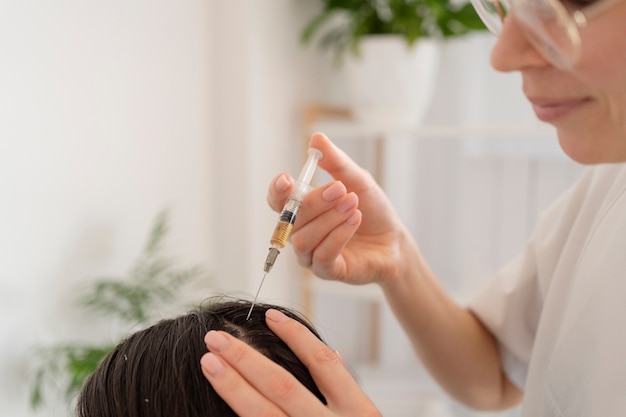Introduction
Hair loss is frustrating. It’s not just about appearance—it affects confidence, too. You’re not alone if you’ve noticed more hair on your pillow or in the shower drain. Many people search for solutions, but knowing what works with so many options is tough.
PRP (Platelet-Rich Plasma) therapy has gained attention as a natural hair restoration treatment. Best PRP Hair Treatment in Islamabad, Pakistan It’s used by Dr. Taskeen Iqbal in Islamabad to help people regrow hair without surgery. But does it live up to the hype? Let’s break it down and see if PRP is worth it.
What Is PRP Hair Treatment?
PRP therapy uses your blood to stimulate hair growth. Here’s how it works:
A small amount of blood is drawn from your arm and spun in a centrifuge. Key Benefits of PRP Hair Treatment for Hair Loss This separates the platelet-rich plasma, full of growth factors that help repair tissues and stimulate hair follicles. The concentrated plasma is then injected into thinning areas of the scalp to encourage hair regrowth naturally.
Because PRP comes from your body, there’s no risk of allergic reactions. That’s a big reason why people prefer it over medications or chemical-based treatments.
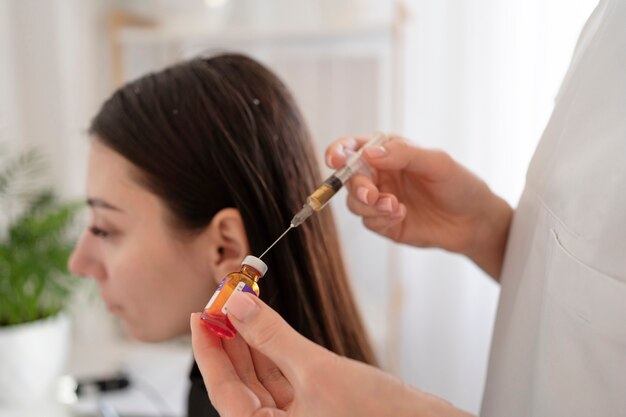
Does PRP Work?
The big question: Is PRP effective for hair regrowth? The short answer—yes, but with some conditions.
Studies show that PRP improves hair thickness, density, and strength. A 2019 study found that 60-70% of patients saw noticeable improvement after a few sessions. A 2021 study showed similar results, with participants experiencing reduced hair shedding and more vigorous regrowth.
But PRP isn’t a miracle cure. It works best for thinning hair and early-stage hair loss. If your hair follicles are entirely dead, PRP won’t bring them back to life. For advanced baldness, a hair transplant might be a better option.
Who Is PRP Hair Treatment Best For?
PRP is ideal for people who still have active hair follicles but notice thinning or increased hair fall. It’s particularly effective for:
- Men and women with hereditary hair loss (pattern baldness).
- People with thinning hair but not complete baldness.
- Those looking for a natural alternative to medication or surgery.
- Individuals with hair shedding due to stress, hormonal changes, or post-pregnancy.
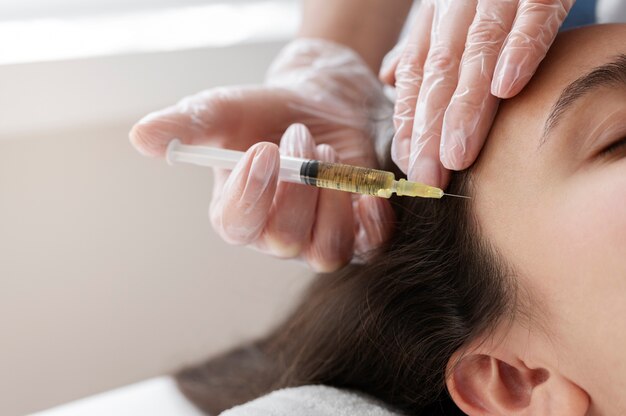
On the other hand, PRP might not work as well if you have:
- Completely bald areas with no active follicles.
- Scalp conditions like infections or severe dandruff.
- Underlying medical issues that affect hair growth.
The best way to know if PRP is right for you is to consult a specialist like Dr. Taskeen Iqbal, who can assess your hair and recommend the best approach.
How Long Does It Take to See Results?
PRP isn’t instant. It works by gradually improving hair strength and growth over several months.
- First Few Weeks: You might notice less hair shedding. Some people feel their scalp is healthier.
- 3 to 4 Months: Small new hairs may appear in thinning areas.
- 6 to 12 Months: Hair becomes noticeably thicker and stronger.
Most people need three to six sessions to see full results, about four to six weeks apart. After the initial treatment, maintenance sessions every six to twelve months keep the results going.
If you’re looking for quick, overnight regrowth, PRP isn’t the answer. But if you’re patient, the results can be impressive.
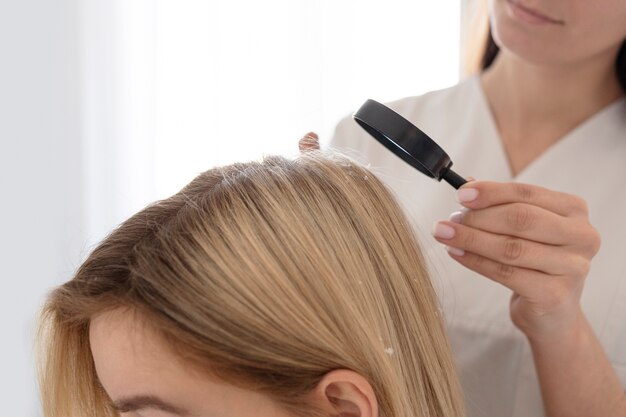
PRP vs. Other Hair Loss Treatments
How does PRP compare to other options? Let’s take a look.
- Minoxidil (Rogaine): A topical treatment that slows hair loss and stimulates new growth. It works for some but requires daily use.
- Finasteride (Propecia): An oral medication that blocks the hormone linked to hair loss. It is more effective for men but can cause side effects.
- Hair Transplants: A surgical procedure that moves hair from one area to another. Permanent results are expensive and require recovery time.
PRP fits in between—it’s not as invasive as a transplant but more effective than over-the-counter products. It’s also a natural option, which appeals to those wanting to avoid medications.
What Affects PRP Treatment Success?
PRP works well for many, but results vary. Here’s what makes a difference:
- The Number of Sessions – One session won’t do much. Multiple treatments over time bring better results.
- Overall Health & Lifestyle – A healthy diet, good scalp care, and low stress help PRP work better.
- Stage of Hair Loss – Early hair thinning responds best. PRP can’t regrow hair on completely bald spots.
- Skill of the Doctor – A trained specialist ensures injections are done correctly, which impacts results.
At Dr. Taskeen Iqbal’s clinic in Islamabad, PRP is done with advanced techniques to maximize effectiveness.
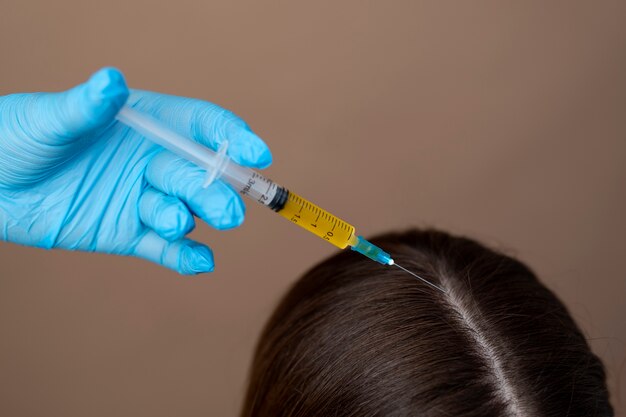
Is PRP Safe?
Since PRP uses your blood, side effects are minimal. Some people experience:
- Mild redness or swelling at the injection site.
- Slight tenderness for a day or two.
Severe side effects are rare. Infections or prolonged discomfort only happen if the procedure isn’t done correctly, so choosing the right doctor is essential.
If you have blood disorders chronic illnesses, or take certain medications, talk to a doctor first.
Why Choose Dr. Taskeen Iqbal for PRP in Islamabad?
Not all PRP treatments are the same. The technique, experience, and expertise of the doctor performing the procedure matter.
Dr. Taskeen Iqbal is one of Islamabad’s leading specialists in PRP hair restoration. PRP Hair Treatment Side Effects: What to Expect She uses advanced methods to ensure patients get the best results possible. Her personalized approach helps determine if PRP is the right fit and tailors the treatment to each individual’s needs naturally.
Her clinic has the latest technology, ensuring safe and effective PRP treatments. Many patients report noticeable hair regrowth after receiving care from their team.
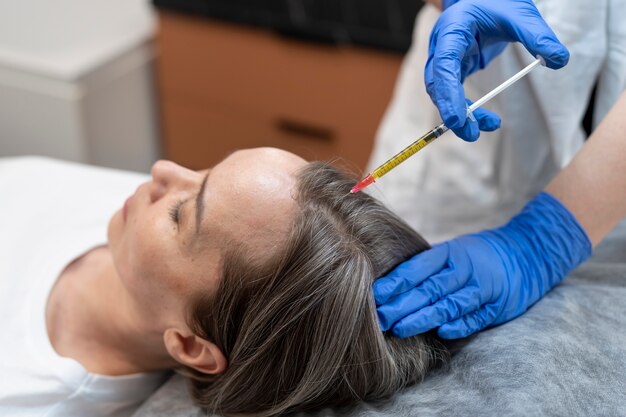
How Much Does PRP Cost in Islamabad?
PRP prices vary based on:
- The clinic’s reputation and expertise.
- The number of sessions required for optimal results.
- The technology and techniques used.
While cheaper clinics might seem attractive, quality matters more. Choosing an experienced specialist like Dr. Taskeen Iqbal ensures you get a treatment that works.
During a consultation, you’ll get a custom treatment plan and a clear idea of the costs involved.
Final Thoughts: Is PRP Worth It?
PRP isn’t magic, but it’s a real, science-backed solution for many struggling with hair loss. It can strengthen existing hair, reduce shedding, and encourage new growth if caught early.
It’s not for everyone. If hair loss is too advanced, PRP may not be enough. However, for those in the early stages, it can delay further hair loss and help maintain thickness naturally.
If you’re considering PRP hair treatment in Islamabad, booking a consultation with Dr. Taskeen Iqbal is a significant first step. She can evaluate your hair and help you decide if PRP suits you.
FAQs
Does PRP regrow hair?
Yes, PRP can help regrow hair in areas where follicles are still active. It strengthens existing hair, reduces shedding, and promotes new growth. Dr. Taskeen Iqbal’s PRP treatments in Islamabad are designed to maximize hair regrowth using advanced techniques.
Is PRP treatment 100% effective?
No treatment guarantees 100% success, and PRP is no exception. While it works for many, results depend on hair loss stage, health, and treatment consistency. Dr. Taskeen Iqbal tailors each PRP session to improve effectiveness based on individual needs.
What is the failure rate of PRP?
PRP has a lower success rate in advanced baldness or when done incorrectly. Around 10-20% of patients may see minimal results, especially if hair follicles are inactive. Dr. Taskeen Iqbal ensures precise PRP application to enhance success rates.
Is PRP worth it?
For those with early hair thinning, PRP is a great non-surgical option. It helps slow hair loss and improve hair quality without medications or transplants. With Dr. Taskeen Iqbal’s expertise, patients in Islamabad get high-quality PRP treatment for the best possible results.
Can PRP fail?
PRP can fail if hair loss is too advanced or the treatment isn’t performed correctly. Success also depends on factors like genetics, health, and aftercare. Dr. Taskeen Iqbal’s clinic provides thorough consultations to determine if PRP is the right choice for each patient.

